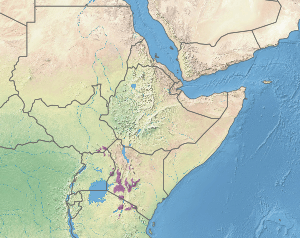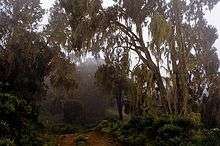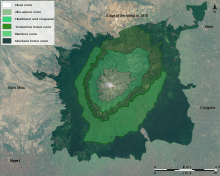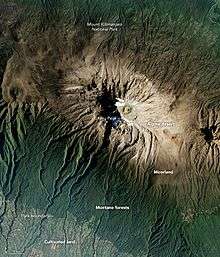East African montane forests
The East African montane forests is a montane tropical moist forest ecoregion of eastern Africa. The ecoregion comprises several separate areas above 2000 meters in the mountains of South Sudan, Uganda, Kenya, and Tanzania.
| East African montane forests | |
|---|---|
.jpg) Montane rainforest on Mount Kilimanjaro | |
 East African montane forests (in purple) | |
| Ecology | |
| Realm | Afrotropical |
| Biome | Tropical and subtropical moist broadleaf forests |
| Geography | |
| Area | 65,500 km2 (25,300 sq mi) |
| Countries | Kenya, South Sudan, Tanzania, Uganda |
| Conservation | |
| Conservation status | critical |
Setting
The East African montane forests extend across a total of 65,500 square kilometers (25,300 sq mi), in 25 separate enclaves, which range in size from 23,700 to 113 square kilometers. The northernmost enclave is on Mount Kinyeti in the Imatong Mountains of Southern Sudan, extending south through Mount Moroto in eastern Uganda and Mount Elgon on the Kenya-Uganda border. In Kenya and Tanzania, the ecoregion follows the mountains east and west of the Eastern Rift and associated volcanoes, including the Aberdare Range, Mount Kenya, Mount Kulal, Mount Nyiru, Bukkol, and the Nguruman Escarpment in Kenya, and Mount Kilimanjaro, Mount Meru, Ngorongoro, and the Marang forests (Mbulu Highlands and Mount Hanang) in northern Tanzania.[1]
Flora
The ecoregion consists of montane forests, grasslands, and savannas, transitioning to the East African montane moorlands on the highest peaks. The ecoregion is home to the Afromontane flora, which occurs in the mountains of eastern Africa, and is distinct from the lowland flora.
Gallery
 Timberline forest with lichens on Mount Kenya
Timberline forest with lichens on Mount Kenya)_(17973119000).jpg) Montane forest below the bamboo zone on Mount Kenya
Montane forest below the bamboo zone on Mount Kenya Montane forests of Mount Kenya from space
Montane forests of Mount Kenya from space Montane forests of Mount Kilimanjaro from space
Montane forests of Mount Kilimanjaro from space
External links
| Wikimedia Commons has media related to East African montane forests. |
- World Wildlife Fund, ed. (2001). "East African montane forests". WildWorld Ecoregion Profile. National Geographic Society. Archived from the original on 2010-03-08.
References
- "East African montane forests". Terrestrial Ecoregions. World Wildlife Fund. Retrieved June 25, 2011.